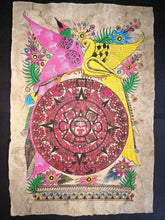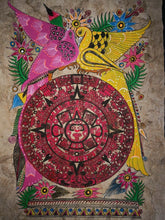This is a gorgeous original work on amate paper. Though there are a number of Mexican artists who are doing this type of work, Ramirez is one of the top ones around. Some of these works are by him, but we also have some works by other top amate artists from the region. These works are watercolor and ink and measure around 23 x 15" (57 x 37cm).
The tiny Mexican village of San Pablito, found in the mountains of Puebla, has been making amate bark paper for centuries. The local people are of Otomί ancestry, and continue to practice this ancient tradition of paper making. To the southwest in the State of Guerrero, amate paper is brightly decorated with beautiful scenes depicting everyday life of the villagers, such as the harvest, fiestas, weddings, religious customs and wildlife." When the Spanish banned the paper in Mexico because it was being used for magic and witchcraft, the remote town was one of the few places to preserve the traditional craft. Today, the artisanal paper is highly prized by Mexican folk art enthusiasts, and most households in San Pablito are involved in paper-making and the craft provides a vital source of income for local families. The paper boom has helped reduce poverty in the village and has provided work for papermakers and people who harvest bark throughout the region.
Locals like Trejo González still honor the spiritual and historical significance of the handmade craftpaper. “It’s not just amate paper, there’s a history behind it. We share our knowledge of it with the whole family.”
The paper is made by stripping the bark from a wild fig, nettle or mulberry tree—each tree provides a different tone, ranging from brown to white. The bark is cleaned and dried before it is placed in a pot of boiling water for seven to eight hours. After boiling, the bark is rinsed in clean water and the craftspeople beat the bark using a stone against a wooden board. The paper is sometimes dyed or decorated with flowers or other items.
Before the arrival of Spanish colonizers to Mexico, amate paper was used extensively by the Aztecs. Because of its connection to indigenous religious practices, it aroused suspicion in the conquering Spanish settlers. Thousands of amate manuscripts were destroyed after the invasion, and the use of amate paper was banned because it was deemed to encourage witchcraft.
By the 20th century, the knowledge of how to produce the paper was only being maintained in a few small towns hidden in the mountainous regions of the states of Puebla and Veracruz. The survival of the tradition has always been closely linked to its ritual use and to this day, residents of the village of San Pablito, who speak a dialect of Otomi and learn Spanish as a second language, still believe that amate paper has mystical powers.
The shamans preserved the tradition of paper-making throughout the period when it was prohibited in Mexico. When foreign academics began studying the use of the paper in the mid-20th century, shamans began producing it commercially and there was an explosion of interest in the topic. Mexico City artists began to incorporate the paper into their art and the Mexican government publicized and promoted the unique indigenous craft.
Some info on the paper making process:
https://www.paperslurry.com/2015/07/23/hand-papermaking-in-mexico-amate-paper-traditional-mayan-techniques/






